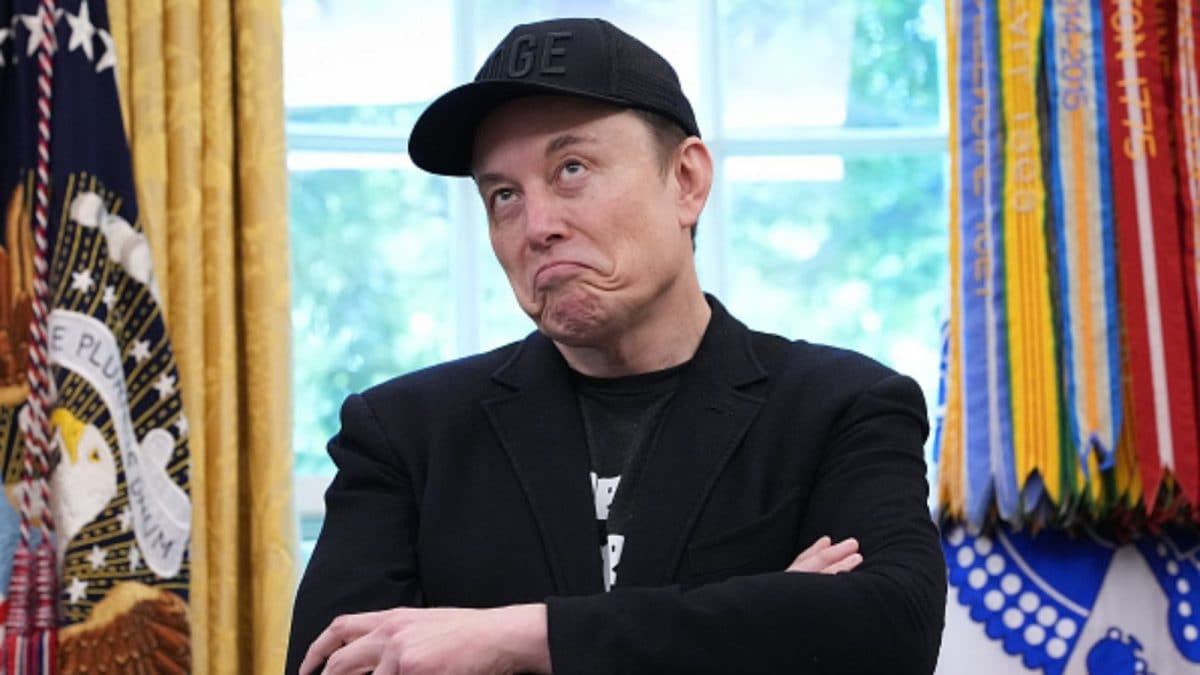Last Updated:July 14, 2025, 10:51 IST
Over 600 million in rural India lack reliable internet, Starlink could deliver high-speed access to remote villages. But costs, licensing norms and terrain could pose a challenge
Users need a Rs 33,000 Starlink kit — comprising a satellite dish, Wi-Fi router, and cables—installed in an open-sky location.
With a population of 1.4 billion and a $4 trillion economy, India faces a significant digital divide. While Mumbai boasts of nearly 70% internet penetration, nearly half of rural India still struggles with unreliable or no connectivity, a 2024 report by the Telecom Regulatory Authority of India (TRAI) said.
So, could Elon Musk’s Starlink be a game-changer in India?
Cleared by India’s Department of Telecommunications (DoT) in June, Starlink aims to deliver high-speed, low-latency internet using a constellation of low Earth orbit (LEO) satellites.
Where will Starlink work best, who is it likely to help first, and how it fits into India’s broader push to bridge its urban-rural tech gap, let’s find out.
How Starlink Works
Starlink’s satellite internet, delivered via a constellation of over 6,750 low Earth orbit (LEO) satellites at 550 km altitude, offers Indian users download speeds of 25-220 Mbps, upload speeds of 5-20 Mbps, and latency of 25-50 milliseconds — making it suitable for streaming, gaming, and video calls. This presents a significant upgrade for rural areas where traditional broadband options remain limited.
However, in India’s metros, fibre broadband still dominates with superior speeds of 100-1000 Mbps downloads, 50-200 Mbps uploads, and ultra-low 5-15 ms latency, while 5G mobile networks deliver 50-500 Mbps speeds. Rural areas typically rely on slower 4G connections (5-30 Mbps downloads) or limited fibre where available.
Users need a Rs 33,000 Starlink kit — comprising a satellite dish, Wi-Fi router, and cables—installed in an open-sky location. A user-friendly app guides placement, making setup accessible without professional help. Monthly plans, starting at Rs 850 (promotional) to Rs 3,000–Rs 4,200, offer unlimited data, per The Economic Times. Starlink’s LEO satellites, using laser communication, outperform geostationary satellites’ 600+ ms latency, ensuring reliability even in remote terrains.
How Starlink Could Benefit Indian Internet Users
Starlink’s entry into India, backed by partnerships with Reliance Jio and Bharti Airtel, addresses critical connectivity gaps and offers transformative benefits:
Bridging The Digital Divide: Over 600 million Indians in rural areas lack reliable internet, per a 2023 Nasscom report. Starlink’s satellite network bypasses the need for costly ground infrastructure, delivering high-speed access to villages in Assam or Ladakh. This enables online education for 68 million schoolgirls, telemedicine for 70% of under-equipped rural health centres, and e-commerce for small businesses, boosting rural economies by 2%, per NITI Aayog estimates.
Empowering Remote Regions: India’s diverse geography poses challenges for fibre networks. Starlink’s coverage, requiring only a clear sky, can connect 90% of these areas, per a 2024 Financial Express analysis. For example, pilgrims during the Amarnath Yatra, a high-altitude trek drawing 500,000 annually, could use Starlink for real-time communication, enhancing safety in areas with no cellular coverage.
Economic & Social Impact: With 5.4 million tech workers driving urban economies, reliable internet is vital. Starlink’s low latency supports remote work, potentially saving Rs 10,000 crore annually in commuting costs, per The Hindu report. In education, 60% of rural students lack online learning access; Starlink could reduce this gap by 20%. For businesses, 30% of SMEs in tier-2 cities like Jaipur face slow internet, per FICCI; Starlink’s speeds could boost productivity by 15%.
Resilience In Crises: India faces frequent natural disasters, with 80% of bridge collapses (1977–2017) linked to floods. Starlink’s resilience, proven in Ukraine’s 2022 conflict, ensures connectivity during crises. In Gujarat’s 2025 bridge collapse, Starlink could have aided rescue coordination in areas with disrupted networks, per an India Today report.
Space Economy Growth: India’s space sector, projected to hit $44 billion by 2033, benefits from Starlink’s entry, per a 2024 FICCI-EY report. It fosters innovation, creating 50,000 tech jobs and aligning with India’s 172 space start-ups, as per a News18 report. Competitive pricing could lower broadband costs, challenging Jio’s free data model.
Where To Install Starlink In India
Starlink’s installation requires a clear view of the sky, avoiding obstructions like trees or buildings. Strategic locations include:
Rural And Tribal Areas: Over 700,000 villages, especially in Bihar, Odisha, and Jharkhand, have internet penetration below 30%, per TRAI. Installing Starlink dishes in community centres or schools, as tried in Bhutan, could serve 10,000 users per region.
Remote Regions: The Northeast (e.g., Arunachal Pradesh), Himalayan areas (Ladakh, Himachal Pradesh), and island territories (Andaman & Nicobar) could see fibre infrastructure expand with Starlink’s portable kits, installed on rooftops or open fields. This can connect 50,000 users initially, per Indian Express. The Amarnath Yatra route, at 3,800 metres, could host temporary base stations for pilgrims.
Disaster-Prone Zones: States like Assam (annual floods) and Gujarat (cyclones) need resilient communication. Starlink dishes on government buildings or mobile units, as used in Ukraine, can ensure uninterrupted service during disasters, supporting 70% of India’s disaster-affected areas, per NDMA 2024 data.
Educational & Health Institutions: With 15,000 schools lacking basic facilities, per a 2024 MoE report, Starlink can enable digital classrooms. Rural health centres, where only 10% offer telemedicine, could install dishes to connect 1 million patients annually, per Ministry of Health and Family Welfare.
Urban Backup: While urban areas like Delhi have 1 Gbps fiber, Starlink’s Rs 3,000 plans can serve as backup during outages, benefiting 30% of tech workers, per Nasscom. Installations on apartment rooftops or offices ensure continuity.
What Could Be The Possible Challenges?
While Starlink’s entry into India holds transformative potential, it will not be without significant challenges. Regulatory hurdles, infrastructure limitations, and affordability concerns are among the biggest roadblocks that could slow down its rollout and adoption.
Regulatory & Licensing Compliance
India has a tightly regulated telecom sector. Though Starlink received in-principle approval from the Department of Telecommunications (DoT) in June, it must still comply with licensing norms, spectrum allocation policies, and data localisation rules. A report by Reuters suggests that Starlink still needs to establish ground infrastructure and secure the spectrum from the government. Moreover, the SpaceX-owned service needs to demonstrate through testing and trial that it meets the security rules set by IN-SPACe. This means, Starlink may start offering its services in India either by the end of the year or sometime next year.
Cost And Affordability
One of the biggest challenges will be pricing. Starlink’s global monthly subscription rates are steep by Indian standards. Even if subsidised, the upfront cost of Starlink’s user terminals—often around Rs 40,000–Rs 60,000—may be unaffordable for many rural households. Without targeted subsidies or partnerships with government schemes like BharatNet, mass adoption may be limited.
Rural Deployment & Terrain
While Starlink is ideal for remote areas with poor infrastructure, regions with high tree cover, hilly terrain, or frequent power outages may face signal disruption. Additionally, awareness and technical literacy remain low in underserved communities, which could slow installation and service adoption.
How India Can Maximise Starlink’s Impact
Expand Infrastructure: Deploy 1,000 ground stations by 2027, per IN-SPACe, to support 3 Tbps bandwidth, serving 50 million users.
Security Compliance: Enforce data localisation and 20% indigenised ground segments, per DoT norms, to address espionage fears.
Integrate with Telecom: Jio and Airtel’s retail networks can distribute kits, covering 70% of India’s telecom market, per The Hindu.
Shilpy Bisht, Deputy News Editor at News18, writes and edits national, world and business stories. She started off as a print journalist, and then transitioned to online, in her 12 years of experience. Her prev…Read More
Shilpy Bisht, Deputy News Editor at News18, writes and edits national, world and business stories. She started off as a print journalist, and then transitioned to online, in her 12 years of experience. Her prev… Read More
view comments
- First Published:
News india Elon Musk’s Starlink In India: A New Era For Internet Connectivity Or Just Hype?Disclaimer: Comments reflect users’ views, not News18’s. Please keep discussions respectful and constructive. Abusive, defamatory, or illegal comments will be removed. News18 may disable any comment at its discretion. By posting, you agree to our Terms of Use and Privacy Policy.

